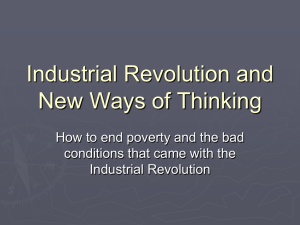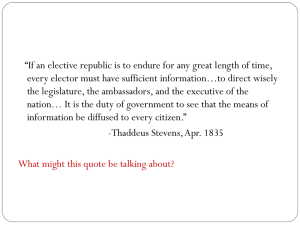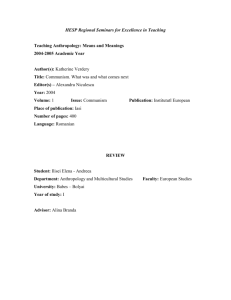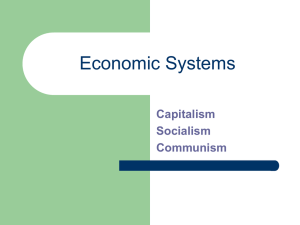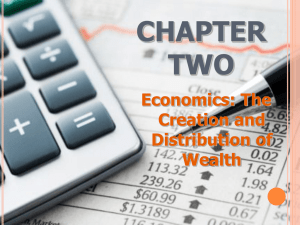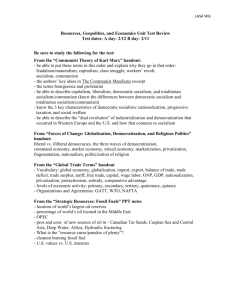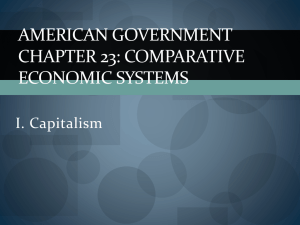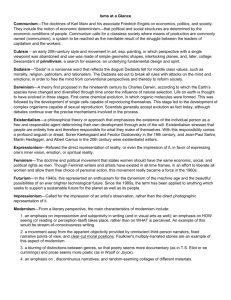Economic Systems - Federal Reserve Bank of Dallas
advertisement
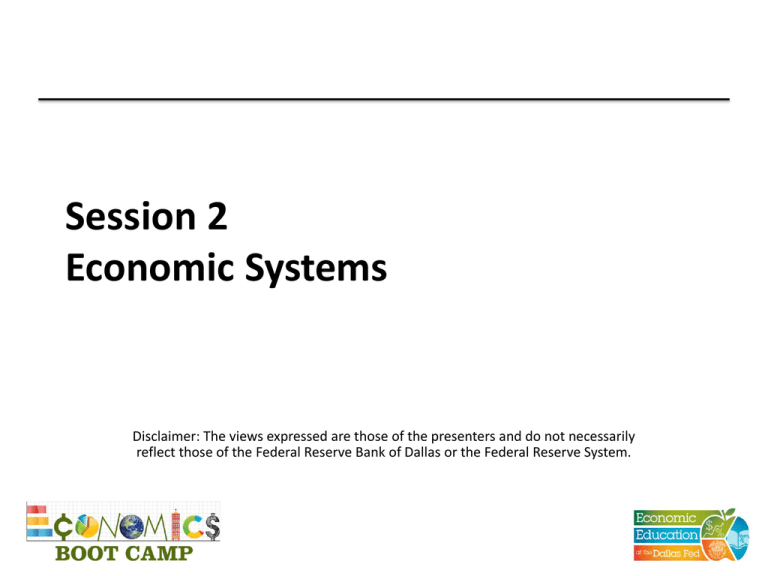
Session 2 Economic Systems Disclaimer: The views expressed are those of the presenters and do not necessarily reflect those of the Federal Reserve Bank of Dallas or the Federal Reserve System. TEKS (1) Economics. The student understands the concepts of scarcity and opportunity costs. The student is expected to: (B) describe how societies answer the basic economic questions; TEKS (5) Economics. The student understands free enterprise, socialist, and communist economic systems. The student is expected to: (A) describe the basic characteristics of economic systems, including property rights, incentives, economic freedom, competition, and the role of government; (B) compare the free enterprise system, socialism, and communism using the basic characteristics of economic systems; (C) examine current examples of free enterprise, socialist, and communist economic systems; (D) understand that the terms free enterprise, free market, and capitalism are synonymous terms to describe the U.S. economic system TEKS (6) Economics. The student understands the basic characteristics and benefits of a free enterprise system. The student is expected to: (A) explain the basic characteristics of the U.S. free enterprise system, including private property, incentives, economic freedom, competition, and the limited role of government; (B) explain the benefits of the U.S. free enterprise system, including individual freedom of consumers and producers, variety of goods, responsive prices, investment opportunities, and the creation of wealth (D) analyze the costs and benefits of U.S. economic policies related to the economic goals of economic growth, stability, full employment, freedom, security, equity (equal opportunity versus equal outcome), and efficiency. Teaching the Terms • • • • • • • Free enterprise Communism Socialism Incentives Property rights Competition Prices • • • • • Consumers Producers Resource allocation Economic freedom Role of government Basic Economic Questions What to produce? • What should be made using available resources? How to produce? • What combination of resources should be used? Who will consume? • How will production be allocated? Two Ends of the Spectrum Command Market Economic Systems Communist (command) Free Enterprise (market) Socialist (mixed) Traditional Comparing Economic Systems Property Rights Incentives Economic Freedom Competition Role of Government Communism Communism Communism Communism Communism Socialism Socialism Socialism Socialism Socialism Free Enterprise Free Enterprise Free Enterprise Free Enterprise Free Enterprise Economic and Social Goals • • • • • Freedom Growth Stability Equity Efficiency Economic Freedom • Consumers decide how to spend or save their incomes • Workers are free to choose a career or change jobs • People are free to establish new businesses or close old ones Economic Growth • An increase in the production of goods and services over time • Affects the standard of living in a society Economic Stability • Price stability – Avoiding inflation, a rise in the average price level – Avoiding deflation, a fall in the average price level • Full employment – using all of an economy's scarce resources (e.g. labor) Economic Equity • Fairness in economic dealings – Evaluating transactions in the marketplace – Overall distribution of income • Criteria for judging equity – Equal opportunity – Equal outcomes Economic Efficiency • Not wasting scarce resources • Two goals – Produce the goods and services people want most – Economize resources in the production of goods and services to minimize the real costs of production Activity • Rank the economic and social goals from least important to most important. – As an individual – As a group – As a class • Discuss how command and market economies would address each goal. Benefits of the Free Enterprise System • Individual freedom of consumers and producers • Variety of goods • Responsive prices • Investment opportunities • Creation of wealth Hybrid Systems Market Socialism Social Democracy State Capitalism Questions?

